Hanya menunjukkan diagram kasus penggunaan di UML notasi tidak cukup. Setiap kasus penggunaan disertai dengan teks yang menjelaskan tujuan dari kasus penggunaan serta fungsi apa yang dicapai ketika sebuah kasus penggunaan dieksekusi.
The spesifikasi kasus penggunaan biasanya dibuat dalam fase analisis dan desain secara iteratif.
- Pada awalnya, hanya deskripsi singkat tentang langkah-langkah yang diperlukan untuk menjalankan alur normal dari kasus penggunaan (yaitu, fungsi apa yang disediakan oleh kasus penggunaan) yang ditulis.
- Seiring dengan kemajuan analisis, langkah-langkah tersebut diperinci untuk menambahkan lebih banyak detail.
- Akhirnya, alur-alur pengecualian ditambahkan ke kasus penggunaan
- Setiap proyek dapat mengadopsi template kasus penggunaan standar untuk pembuatan spesifikasi kasus penggunaan.
Kasus Penggunaan vs Spesifikasi Kasus Penggunaan
Sebuah Kasus Penggunaan menggambarkan tugas yang dilakukan oleh seorang aktor yang menghasilkan hasil bernilai bisnis untuk sebuah bisnis. Sebuah kasus penggunaan dapat divisualisasikan sebagai diagram kasus penggunaan atau/yang dalam format spesifikasi teks terstruktur:
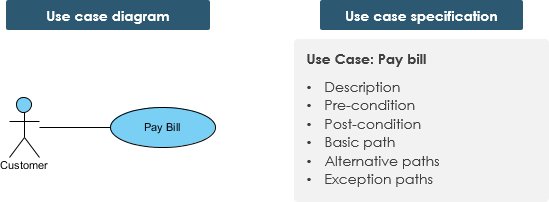
Kasus Penggunaan (tugas — yang ingin dilakukan pelanggan) dapat berupa:
- Interaktif — Sebuah kasus penggunaan sistem menggambarkan interaksi seorang aktor dengan sistem dalam mengejar tujuan bisnis yang ditentukan
- Manual — Sebuah urutan tindakan yang dilakukan oleh seorang aktor
- Otomatis — Sebuah urutan langkah yang dilakukan oleh program atau skrip
Karakteristik Kasus Penggunaan
Sebuah kasus penggunaan memiliki:
- Hanya satu tujuan
- Satu titik awal
- Satu titik akhir
- Beberapa jalur untuk mencapai dari awal hingga akhir
- yaitu. Menentukan perilaku untuk berbagai kemungkinan kondisi
- Setiap kondisi mungkin memerlukan tindakan tertentu
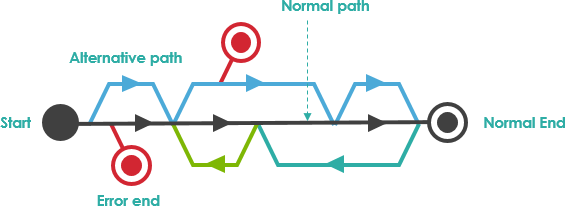
Sebagai Contoh — Pelanggan membayar tagihan:

Ada beberapa jalur untuk mencapai tujuan:
- Pembayaran melalui telepon
- Melalui pos
- Secara langsung
- dengan cek
- dengan uang tunai, dll.
Sebuah jalur yang tidak mengarah ke tujuan:
- Kartu kredit ditolak
Pendekatan Kasus Penggunaan Agile
Model kasus penggunaan dan kasus penggunaan individunya berkembang tingkat demi tingkat seiring waktu. Tidak semua kasus penggunaan dari sebuah model harus ditentukan pada tingkat detail yang sama.
Just-in-Time dan Just-Enough
Kasus penggunaan dapat ditulis pada tingkat data dan cakupan yang berbeda, masing-masing memiliki tujuan:
- Ringkasan: Deskripsi umum dan gambaran luas tentang fungsionalitas sistem atau proses bisnis.
- Tingkat Pengguna : Deskripsi terkait tugas pengguna dan bagaimana mereka berinteraksi dengan sistem; deskripsi dari proses bisnis tertentu. Kasus penggunaan Tingkat Pengguna biasanya dianggap berada pada tingkat tugas yang merupakan pekerjaan utama pengguna.
- Sub-fungsi: Deskripsi aktivitas tingkat bawah yang digunakan untuk menyelesaikan bagian-bagian dari kasus penggunaan inti.
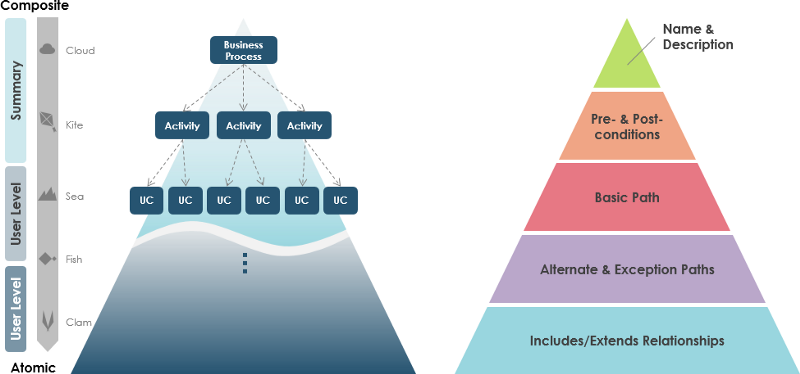
Catatan: Beberapa kasus penggunaan mungkin cukup ditentukan hingga level II. Anda berhenti ketika detail yang cukup dicapai dengan cara yang tepat waktu dan cukup.
Spesifikasi Kasus Penggunaan yang Detail
Kasus penggunaan yang detail adalah representasi tekstual yang menggambarkan urutan peristiwa bersama dengan informasi kasus penggunaan terkait lainnya dalam format tertentu. Orang biasanya mengadopsi template kasus penggunaan standar untuk mencatat informasi detail untuk kasus penggunaan.
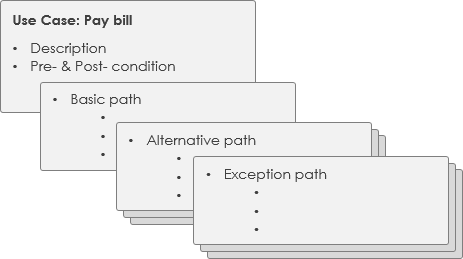
Template Kasus Penggunaan — contoh kasus penarikan ATM
Seperti yang disebutkan sebelumnya, ada beberapa gaya notasi untuk kasus penggunaan (misalnya gaya diagram, bahasa pemodelan terpadu, format tekstual). Apa pun notasi yang digunakan harus mudah dipahami. Anda dapat menggunakan template, seperti yang berasal dari Alistair Cockburn, tetapi juga merupakan opsi untuk menggunakan apa yang paling sesuai untuk tim Anda.
Spesifikasi Kasus Penggunaan
Nama Kasus Penggunaan: Tarik Tunai
Aktor:Pelanggan (utama), Sistem Perbankan (sekunder)
Deskripsi Ringkas: Memungkinkan setiap nasabah bank untuk menarik tunai dari rekening bank mereka.
Prioritas: Harus Ada
Status: Tingkat Detail Sedang
Kondisi Awal: Nasabah bank memiliki kartu untuk dimasukkan ke dalam ATM
ATM berfungsi dengan baik
Kondisi Pasca:
- Nasabah bank telah menerima tunai mereka (dan opsional struk)
- Bank telah mendebit rekening bank nasabah dan mencatat detail transaksi
Jalur Dasar:
- Nasabah memasukkan kartu mereka ke dalam ATM
- ATM memverifikasi bahwa kartu tersebut adalah kartu bank yang valid
- ATM meminta kode PIN
- Nasabah memasukkan kode PIN mereka
- ATM memvalidasi kartu bank terhadap kode PIN
- ATM menampilkan opsi layanan termasuk “Tarik”
- Nasabah memilih “Tarik”
- ATM menampilkan opsi untuk jumlah
- Nasabah memilih jumlah atau memasukkan jumlah
- ATM memverifikasi bahwa ia memiliki cukup uang tunai di dalamnya
- ATM memverifikasi bahwa nasabah berada di bawah batas penarikan
- ATM memverifikasi bahwa ada dana yang cukup di rekening bank nasabah
- ATM mendebit rekening bank nasabah
- ATM mengembalikan kartu bank nasabah
- Nasabah mengambil kartu bank mereka
- ATM mengeluarkan uang tunai nasabah
- Nasabah mengambil uang tunai mereka
Jalur Alternatif:
2a. Kartu tidak valid
2b. Kartu terbalik
5a. Kartu dicuri
5b. PIN tidak valid
10a. Uang tunai tidak cukup di dalamnya
10b. Denominasi uang tunai salah di dalamnya
11a. Penarikan di atas batas penarikan
12a. Dana tidak cukup di rekening bank pelanggan
14a. Kartu bank terjebak di mesin
15a. Pelanggan gagal mengambil kartu bank mereka
16a. Uang tunai terjebak di mesin
17a. Pelanggan gagal mengambil uang tunai mereka
- a ATM tidak dapat berkomunikasi dengan Sistem Perbankan
- b Pelanggan tidak merespons perintah ATM
Aturan Bisnis:
B1: Format PIN
B2: Jumlah percobaan PIN
B3: Opsi layanan
B4: Opsi jumlah
B5: Batas penarikan
B6: kartu harus diambil sebelum uang tunai dikeluarkan
Persyaratan Non-Fungsional:
NF1: Waktu untuk transaksi lengkap
NF2: Keamanan untuk memasukkan PIN
NF3: Waktu untuk memungkinkan pengambilan kartu dan uang tunai
NF4: Dukungan bahasa
NF5: Dukungan untuk tunanetra dan sebagian tunanetra
Jelajahi lebih banyak Contoh Diagram Kasus Penggunaan
Anda dapat mengeditnya secara instan dengan Visual Paradigm Alat Gratis dengan mengklik tautan contoh di bawah:
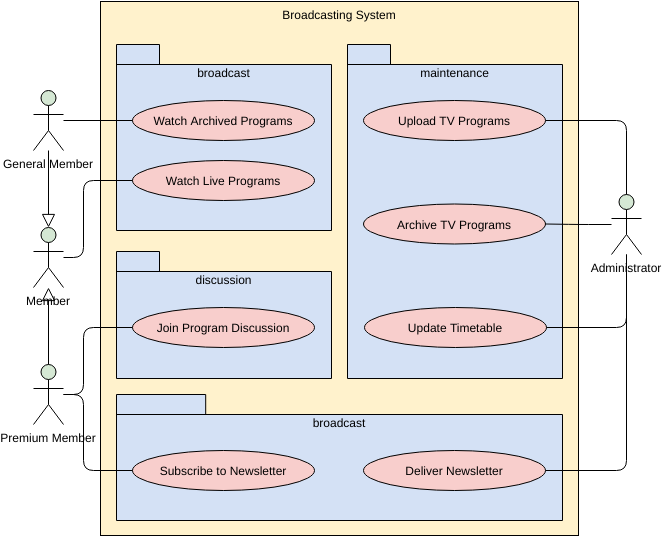
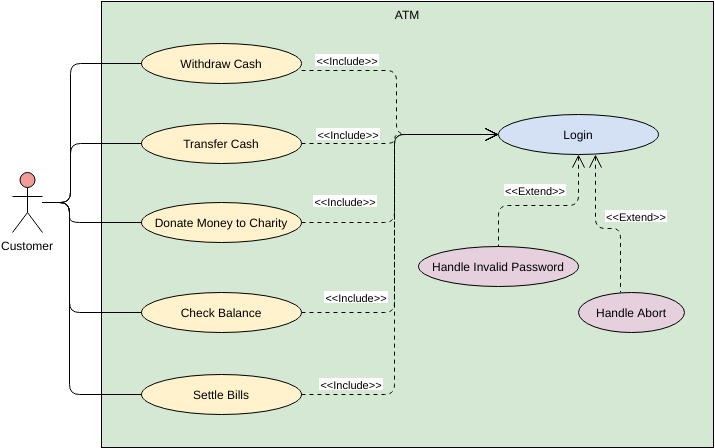
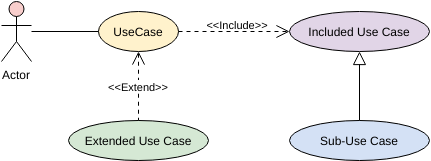


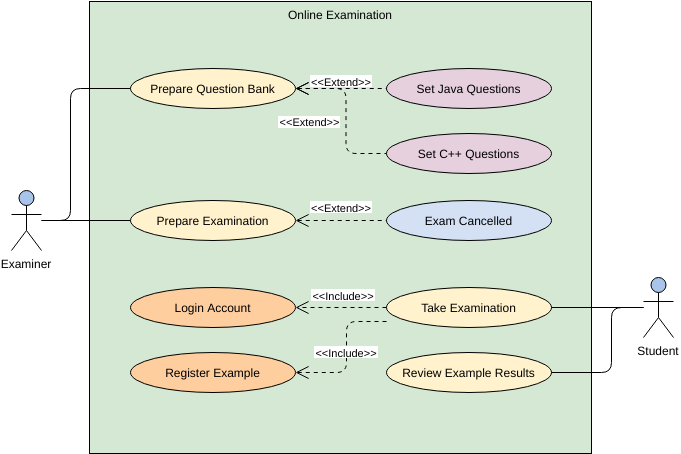
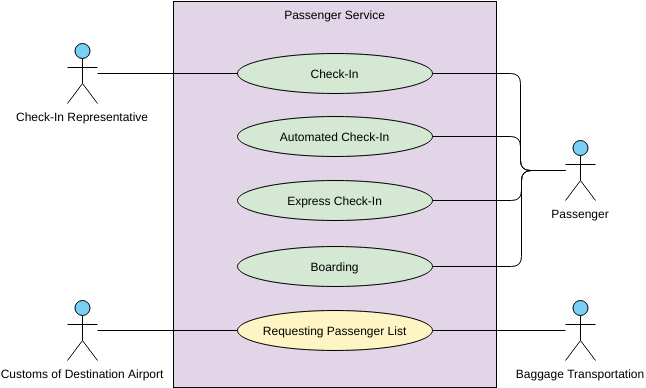
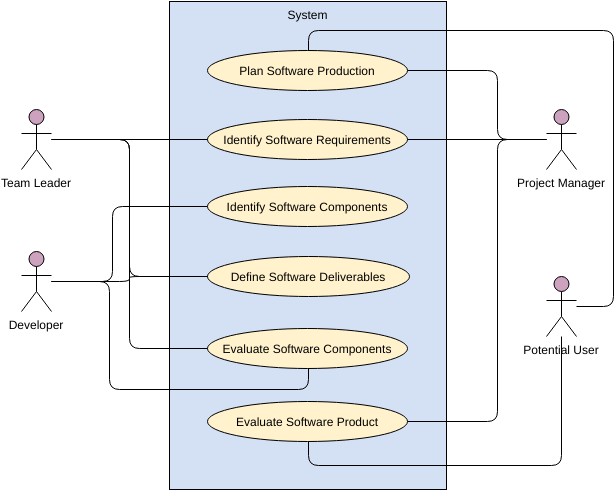
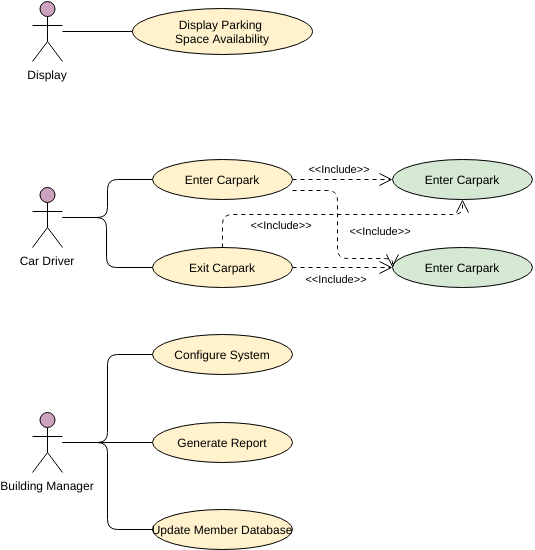
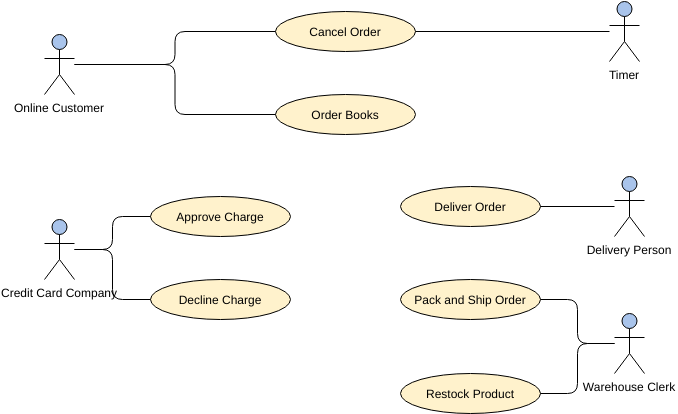

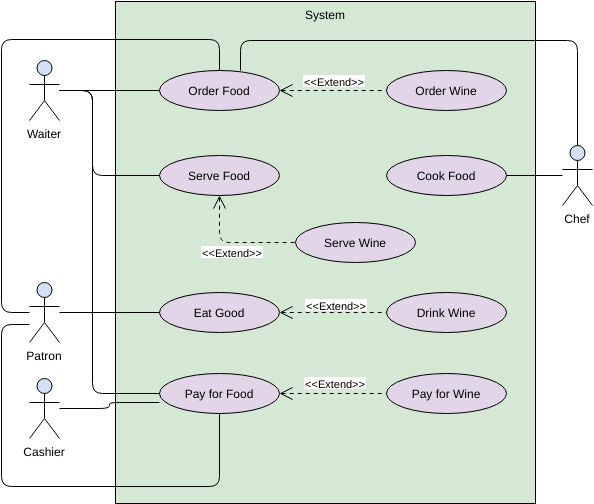
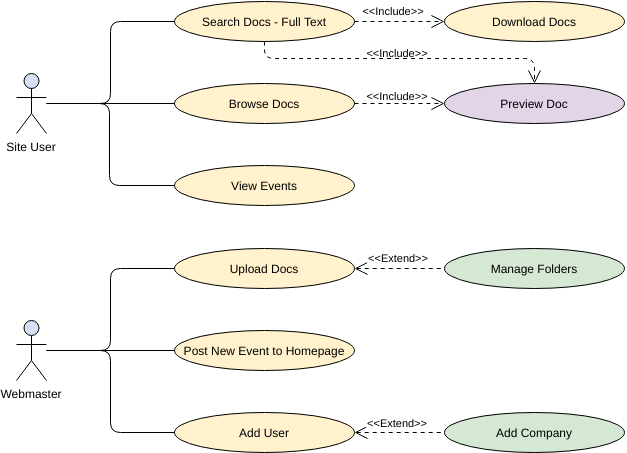
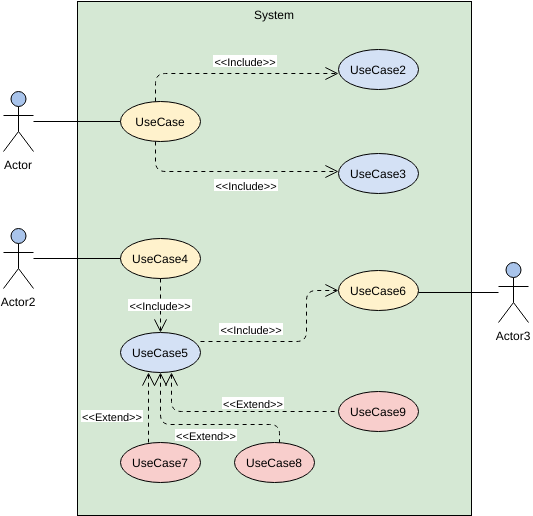
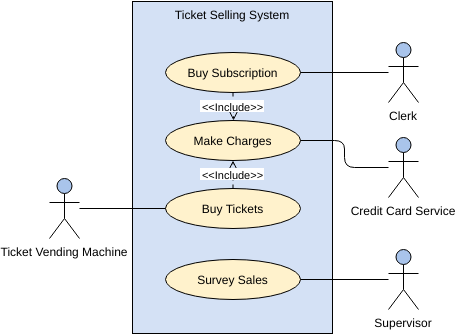
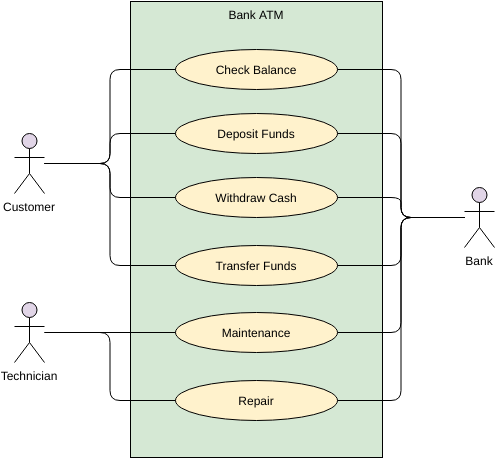
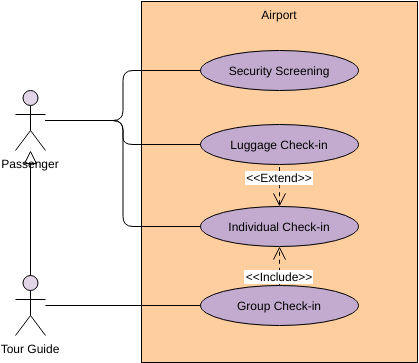
Tautan Terkait
This post is also available in Deutsch, English, Español, فارسی, Français, 日本語, Polski, Portuguese, Ру́сский, Việt Nam, 简体中文 and 繁體中文.













